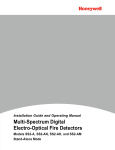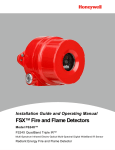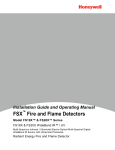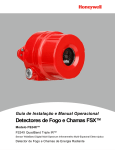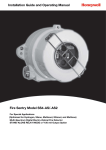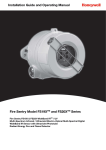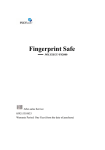Download User Manual - Honeywell Analytics
Transcript
Installation Guide and Operating Manual Multi-Spectrum Digital Electro-Optical Fire Detectors Model SS3 (Models SS3-A, SS3-AN, SS3-AB, and SS3-ABN) Stand-Alone Mode or FS2000 System Mode OPERATOR MANUAL // NOTICES AND TRADEMARKS Notices and Trademarks Copyright 2014 by Honeywell International Inc While this information is presented in good faith and believed to be accurate, Honeywell disclaims the implied warranties of merchantability and fitness for a particular purpose and makes no express warranties except as may be stated in its written agreement with and for its customers. In no event is Honeywell liable to anyone for any indirect, special or consequential damages. The information and specifications in this document are subject to change without notice. The detector must be installed only by qualified professional personnel in accordance with local codes. The protection provided by the gas detector may be impaired if it is used in a manner not specified by Honeywell Analytics. ACCTTL, ALERT-1, ALARM-2, ALERT-1: ALARM 2, ALERT-1: ALARM-2, ATAG, Clean Room Sentry, COP-i, Complete Optical Path Integrity, CM1, CM1-A, DartLogic, FireLogic, Fire Signature Analysis, FireBusI, FireBusII, FirePic, FirePicII, FirePicIII, FirePix, FirePicture, FSC, Fire Sentry Corporation, Fire Sentry Corp., FSX, All FSX Nomenclature Variations (such as: FS2, FS2X, FS3, FS3X, FS4, FS4X, FS5, FS5X, FS6, FS6X, FS7, FS7X, FS8, FS8X, FS9, FS9X, FS10X, FS10X, FS11, FS11X, FS12, FS12X, FS14, FS14X, FS15, FS15X, FS16, FS16X, FS17, FS17X FS18, FS18X, FS19, FS19X, FS20, FS20X, FS24, FS24X, FS24XN, FS26, FS26X, FS26XN), FS7-2173-2RP, FS System 7, FS System 10, FS7-2173, FS7-2173-RP, FS2000, FS System 2000, High Speed Flame & Surveillance Detector, Multi-Spectrum QuadBand Triple IR, Multi-Spectrum TriBand, Multi-Spectrum Tri-Band, Near Band Infrared, Near Band IR, NearBand IR, QuadBand IR, Room Sentry, RS, RS2, SM2, SM3, SS, SS2, SS2X, SS2-A, SS3, SS3-A, SS3X, SS4, SS4-A, SS4X, SnapShot, SLR-BIT, SuperBus, SuperSentry, System 2000, Tri-Mode Plot, QuadBand Triple IR Plus, TriBand, Tri-Band, “FS & FSC triangle logo’s”, WBIR, Wide Band Infrared, WideBand IR, Wide Band IRare registered trademarks of Honeywell International Inc. Other brand or product names are trademarks of their respective owners. Honeywell Analytics HONEYWELL 1 OPERATOR MANUAL // SYMBOL DEFINITIONS Symbol Definitions The following table lists those symbols used in this document to denote certain conditions. Symbol Definition ATTENTION: Identifies information that requires special consideration. TIP: Identifies advice or hints for the user, often in terms of performing a task. REFERENCE-EXTERNAL: Identifies an additional source of information outside of this bookset. REFERENCE-INTERNAL: Identifies an additional source of information within this bookset. Indicates a situation which, if not avoided, may result in equipment or work (data) on the system being damaged or lost, or may result in the inability to properly operate the process. CAUTION: Indicates a potentially hazardous situation which, if not avoided, may result in minor or moderate injury. It may also be used to alert against unsafe practices. CAUTION: Symbol on the equipment refers the user to the product manual for additional information. The symbol appears next to required information in the manual. HONEYWELL 2 OPERATOR MANUAL // TABLE OF CONTENTS TABLE OF CONTENTS TABLE OF CONTENTS .......................................................................................... 3 SECTION 1 FAMILIARIZATION ........................................................................... 4 1.1 1.2 1.3 1.4 SECTION 2 2.2 2.3 Installation Procedure ............................................................................ 2.1.1 Installation Precautions.............................................................. 2.1.2 Device Layout ........................................................................... 2.1.3 Wiring Recommendations .......................................................... 2.1.4 Power Supply Considerations..................................................... Detector Installation ............................................................................... Wiring Detectors .................................................................................... 2.3.1 Wiring as Standalone ................................................................. 2.3.2 Wiring to FS2000 (FireBus) ........................................................ 2.3.3 Wiring the Fire Relay ................................................................. 6 6 6 6 6 7 7 7 7 7 MAINTENANCE AND TROUBLESHOOTING ...................................... 9 3.1 3.2 3.3 3.4 SECTION 4 4 4 4 5 5 5 INSTALLATION ................................................................................ 6 2.1 SECTION 3 Introduction............................................................................................ Stand-Alone Operation ........................................................................... FS2000 System Operation ...................................................................... Overview ............................................................................................... 1.4.1 Model SS3 Detector................................................................... 1.4.2 Testing ...................................................................................... Personnel .............................................................................................. 9 Cleaning Windowed Enclosures and Detectors ........................................ 9 Model SS3 Detector ............................................................................... 9 Detector Repair.....................................................................................10 DETECTOR DATA ......................................................................... 11 Table 1: Model SS3 Detector Connectors - Pinouts .....................................11 Mechanical Layouts ......................................................................................12 Model SS3 Detector Mounting Brackets .........................................................12 Model SS3-A and SS3-AN Detectors .............................................................13 INDEX ............................................................................................ 14 HONEYWELL 3 OPERATOR MANUAL // SECTION 1 FAMILIARIZAT ION SECTION 1 FAMILIARIZATION 1.1 Introduction The Model SS3 Optical Fire/Flame Detectors operate the SAME whether they are connected to the FS2000 Fire Early Warning System (with FS2000 Controller and FireBus) or whether they operate in the Stand-Alone configuration. When the Model SS3 Detectors are connected to the FS2000 System, refer to the Honeywell Analytics document MN0003 entitled "FS2000 FIRE EARLY WARNING SYSTEM - INSTALLATION and OPERATIONS GUIDE". The only difference between FS2000 System Model SS3 Detectors and a Stand-Alone SS3 Detectors is how each is wired. Sections 1.2 and 1.3 below explain the wiring differences. The SS3 products consist of the Models SS3-A, SS3-AN, SS3-AB and SS3-ABN. Each detector is housed in an ABS white plastic enclosure. The cost-effective Model SS3 fire detector products were designed for indoor applications and applications where a low profile detector is preferred. The Models SS3-A and SS3-AN are Multi-Spectrum Optical Fire Detectors which utilize the wide band infrared (IR), visible (VIS), and ultraviolet (UV) spectral bands. The SS3-A uses a latching relay and the SS3-AN has a NON-latching relay and auto resets. Both feature a wide 120 degree field of view. The Models SS3-AB and the SS3-ABN are Ultraviolet (UV) Optical Fire Detectors which feature a wide 180 degree field of view back-facing UV sensor for use in enclosed areas such as wet stations or gas cabinets. The SS3-AB uses a latching relay and the SS3-ABN uses a NON-latching relay and auto resets. 1.2 Stand-Alone Operation For Stand-Alone operation, the Model SS3 Detectors may be connected to a FM/UL Approved Fire/Security Panel. The Model SS3 Detector operates on 24 volts DC. The Model SS3 Detector, when operated in the StandAlone mode, uses its Fire relay to interface to FM/UL Approved Fire /Security Panels 1.3 FS2000 System Operation For FS2000 System operation, the Model SS3 fire signals are sent digitally to the FS2000 System Controller using the four wire FS2000 FireBus. The FireBus provides the 24 volts DC power for the Model SS3 Detector and RS-485 digital communication (Refer to Honeywell Analytics document MN0003 entitled "FS2000 FIRE EARLY WARNING SYSTEM INSTALLATION and OPERATIONS GUIDE"). For special remote alarm applications, users may connect directly to the Model SS3's Fire relay connector. HONEYWELL 4 OPERATOR MANUAL // SECTION 1 FAMILIARIZAT ION 1.4 Overview 1.4.1 Model SS3 Detector The Model SS3 Detectors are micro-computerized devices. The Detectors’ logic "brain" alarms to fires quickly. There is one LED on the Model SS3 Detectors that indicate the state of the Detector. If the LED blinks approximately every 10 seconds, then the Detector is in Normal Operation When a Model SS3 Detector alarms to a fire, it energizes its Fire relay and turns on its red LED. 1.4.2 Testing The Model SS3 Detectors contain an internal monitoring circuit for selftesting. For testing the Model SS3-A and SS3-AN Detectors end-to-end for both optical path and window cleanliness, use a Honeywell Analytics Model DD85001 UV/IR Test Lamp. The Model SS3-AB and SS3-ABN can be tested using the Model 85001 and Model 85001(B) UV testers. HONEYWELL 5 OPERATOR MANUAL // SECTION 2 INSTALLATION SECTION 2 INSTALLATION 2.1 Installation Procedure This section describes the installation of the Model SS3 Detector for the Stand-Alone mode. It is recommended that junction boxes be used to wire the Model SS3 Detectors.. 2.1.1 Installation Precautions The following precautions should be observed during installation of Model SS3 Detectors. Double-check to make sure that the external electrical power is turned OFF before connecting to the Model SS3 Detector. 2.1.2 Device Layout Model SS3 Detectors should be located to cover the specific "fire threat" areas. The Model SS3-A and SS3-AN Multi-Spectrum Detectors’ field of view is 120º with a range of 30 feet to an industry-standard one square foot Type B gasoline pan fire. In area coverage applications the Detectors should be located with overlapping fields of view to insure complete coverage of the area. Detectors should also be located away from strong RF (Radio Frequency) sources. The Model SS3-AB and SS3-ABN UV Fire Detectors are designed for enclosed areas and feature a wide 180º field of view. 2.1.3 Wiring Recommendations Honeywell Analytics recommends using junction boxes to help prevent problems with intermittent connections. Install a junction box near each Model SS3 Detector location. Next, wire each Model SS3 Detector to its junction box. Use screw-down terminal strips inside the junction box to make the connections to the Detector's terminals and a UL/FM Approved Fire Alarm Panel. Use UL/FM Approved junction boxes and terminal strips. Avoid wire splices. However, if wire splices are necessary, Honeywell Analytics recommends soldering all splices. The use of good wiring practices will greatly improve the ease of installation, improve reliability, and allow easier servicing. 2.1.4 Power Supply Considerations The Model SS3 Detectors use 12 or 24 volts DC at a maximum current of 40 milliamps. Make sure that the Panel's power supply can handle the current load of the total number of Model SS3 Detectors connected to it. For example, if 10 each Model SS3 Detectors are used on one Panel's power supply, (multiply 10 times 40 milliamps), the Panel's power supply must be able to handle at least 400 milliamps. This current load must also be considered when calculating the Panel's power backup requirements for 24 hour backup. HONEYWELL 6 OPERATOR MANUAL // SECTION 2 INSTALLATION 2.2 Detector Installation Although not required, Honeywell Analytics recommends using the Mounting Bracket when installing the Model SS3 Detector to a wall or junction box. a. Choose fasteners for the bracket that will secure it solidly to the type of material at the enclosure location. b. Mount the bracket to the wall. c. Install the Model SS3 Detector enclosure onto the bracket 2.3 Wiring Detectors The Model SS3 Detector may be wired for use on the FS2000 System or to another Control Panel in the Standalone configuration. Regardless of which type of Controller or System the Detector is wired to the Fire Relay will function the same. There are several ways to wire the Fire Relay to a Control Panel or Initiating Circuit. See the manual for the control panel you will be using for specific wiring information. 2.3.1 Wiring as Standalone Connect the 24 volt DC Power Supply wires into the connector and firmly tighten down the slotted screws with a small screwdriver. DO NOT CONNECT ANY WIRES TO J1 - Pin 2 or J1 - Pin 3. Do NOT over tighten or the screws may strip or break. Refer to Figure 4, Model SS3 Detector Wiring. Pin 1 Black Ground (-) 2.3.2 Pin 2 Green or Blue NOT USED Pin 3 White or Yellow NOT USED Pin 4 Red Power (+) Wiring to FS2000 (FireBus) Connect the FireBus Cable wires into the connector and firmly tighten down the two slotted screws with a small screwdriver. Do NOT over tighten or the screws may strip or break. Refer to Figure 4, Model SS3 Detector Wiring. Pin 1 Black Ground (-) 2.3.3. Pin 2 Green or Blue FireBus (Rx) Pin 3 White or Yellow FireBus (Tx) Pin 4 Red Power (+) Wiring the Fire Relay For Stand-Alone or FS2000 systems: Connect the initiating circuit wires to the four pin WECO terminal. Install the wires into Pins 7 and 8 (for Normally Open relay) or Pins 6 and 7 (for Normally Closed relays) and firmly tighten down the slotted screws with a small screwdriver. There is HONEYWELL 7 OPERATOR MANUAL // SECTION 2 INSTALLATION an internal 10K ohm resistor between Pins 5 and 6 for circuits which require an End of Line (Supervision) resistor. One common configuration is to Jumper Pins 5 to 8 and to connect the initiating circuit to Pins 7 and 8. Refer to Figure 4, Model SS3 Detector Wiring, for more details on relay connections. Figure 1 Model SS3 Detector Connection Diagrams Figure 2 Model SS3 Detectors Wiring HONEYWELL 8 OPERATOR MANUAL // SECTION 3 MAINTENANCE AND TROUBLESHOOTING SECTION 3 MAINTENANCE AND TROUBLESHOOTING 3.1 Personnel The following will aid in troubleshooting the Model SS3 Detectors. Tests must be performed by qualified authorized personnel observing standard safety practices. Although the Model SS3 Detector operates on safe 24 volts DC, the FM/UL Approved Fire Alarm Panel's power supply may operate on a dangerous 120 or 240 volts AC. WARNING: Hazardous voltages may be present during testing procedures. Serious injury or death may result if personnel fail to observe safety precautions. 3.2 Cleaning Windowed Enclosures and Detectors The optical windows on the Model SS3 Detector should be cleaned periodically on a regular maintenance schedule. For clean applications, this may be every month. However, for extremely dirty applications a cleaning schedule of every day may be necessary. Clean the windows on the Model SS3 Detectors whenever they are handled, whenever the windows look dirty, or whenever the Model SS3 Detector fails to pass an end-to-end test with a Handheld Tester. Use a blast of an air hose or an oil-free cloth to clean the enclosure windows. Oil degrades the performance of UV detectors. Occasionally, the use of a solvent such as alcohol may be required. No disassembly of the Model SS3 Detector is required. Do not use silicone-based or commercial window cleaning products. They will degrade the model SS3 detector performance. 3.3 Model SS3 Detector CAUTION: Model SS3 Detectors are susceptible to permanent damage due to electrostatic discharge (ESD). HONEYWELL 9 OPERATOR MANUAL // SECTION 3 MAINTENANCE AND TROUBLESHOOTING 3.4 Detector Repair Return a defective detector to the factory for repair service. There are NO user serviceable parts in a Model SS3 Detector. If a Model SS3 Detector must be shipped back to the factory for repair, it MUST be packed in static protected material. An RMA (Return Material Authorization) is required for all returns to the factory. Contact Customer Service for an RMA number before shipping a unit back to the factory. HONEYWELL 10 OPERATOR MANUAL // SECTION 4 DETECTOR DATA SECTION 4 DETECTOR DATA Table 1: Model SS3 Detector Connectors - Pinouts Detector Input Power Fire Relay PIN PIN 1 HONEYWELL DC Return or Ground (-) 5 Fire Relay EOL Resistor (10K ohms) 2 FireBus Communication (-) 6 Fire Relay Normally Closed 3 FireBus Communication (+) 7 Fire Relay Common 4 Power (+24 Volts DC) 8 Fire Relay Normally Open 11 OPERATOR MANUAL // SECTION 4 DETECTOR DATA Mechanical Layouts P.N. 188424 for SS3-A and SS3-AN (Included with Detector) P.N. 188424(B) for SS3-AB and SS3-ABN (Included with Detector) Figure 3 Model SS3 Detector Mounting Brackets HONEYWELL 12 OPERATOR MANUAL // SECTION 4 DETECTOR DATA Figure 4 Model SS3-A and SS3-AN Detectors Figure 5 Model SS3-AB and SS3-ABN Detectors HONEYWELL 13 OPERATOR MANUAL // INDEX INDEX C J Cleaning Products ................... 9 Junction Box ........................... 6 D L Detector Cleaning ................... 9 Enclosure ............................... 7 FireBus ................................... 7 LED........................................ 5 Maintenance Schedule ............ 9 Mounting Brackets................. 12 Pinout................................... 11 Replacement ........................... 9 SS3- ..................................... 13 Standalone ............................. 7 Status..................................... 5 Wiring............................ 7, 8, 11 Layout Planning ...................... 6 F False Alarms ........................... 5 FireBus ............................... 4, 5 FireBus Wiring..................................... 6 FireLogic ................................ 5 Flame Detector See Detector 5 I Installation .............................. 6 Detector ................................. 7 Enclosure ............................... 7 Precautions............................. 6 HONEYWELL M Maintenance ........................... 9 Mounting Brackets ................ 12 P Personnel - Qualified ............... 9 Power..................................... 6 R Relay Fire .................................. 8, 11 S SS3 See Detector................ 4 Stand-Alone ............................ 4 T Test Source ............................ 5 Theory of Operation ................ 5 Troubleshooting ...................... 9 W Wiring Detector ................................. 8 14 OPERATOR MANUAL // LIMITED WARRANTY Limited Warranty Honeywell Analytics warrants its Products against defects in material and workmanship under normal use and service for a period of two (2) years from the date of shipment as described herein. Honeywell Analytics, at its option, will repair or replace, at no charge, such products found to be defective during the warranty period provided that they are returned in accordance with the terms of this warranty. Replaced parts or boards are warranted for the balance of the original applicable warranty period. All Replaced parts of Products shall become the property of Honeywell Analytics. This express limited warranty is extended by Honeywell Analytics to the original purchaser only and is not assignable or transferable to any other party. This is the complete warranty for the Products manufactured by Honeywell Analytics. Honeywell Analytics assumes no obligations or liability for additions or modifications to this warranty unless made in writing and signed by an officer of Honeywell Analytics. Honeywell Analytics does not warrant the installation, maintenance or service of its Products. Honeywell Analytics is not responsible in any way for ancillary equipment not furnished by Honeywell Analytics, which is attached to or used in connection with its Product(s), or for operation of the Product(s) with ancillary equipment and all such equipment if expressly excluded from this warranty. This warranty sets forth the full extent of Honeywell Analytics’ responsibility regarding the Products’ repair or replacement at Honeywell Analytics’ options, is the exclusive remedy. This Warranty is given in lieu of all other Express Warranties, Implied Warranties, including without limitation, Implied Warranties of Merchantability and fitness for a particular purpose, are limited to the duration of this Limited Warranty. In no other event shall Honeywell Analytics be liable for damages in excess of the purchased price of the product(s), for any loss of use, loss of time, inconvenience, commercial loss, lost profits or savings or other incidental, special or consequential damages arising out of or in connection with the use or inability to use such product, to the full extent such may be disclaimed by law. THIS WARRANTY DOES NOT COVER: 1. Defects or damage resulting from use of the Product(s) in other than its normal and customary manner. 2. Defects or damage from misuse, accident, or neglect. 3. Defects or damage from improper testing, operation, maintenance, installation, alteration, modification or adjustment. 4. Product(s) subject to unauthorized Product modifications, disassemblies or repairs (including, without limitation, the audition of the product of non-Honeywell Analytics supplied equipment) which adversely affect performance of the Product(s) to interfere with Honeywell Analytics’ normal warranty inspection and testing of the Product(s) to verify any warranty claim. 5. Product(s) that have had the serial number removed or made illegible. 6. Freight cost to the repair facility. 7. A Product which due to illegal or unauthorized alteration of the software/firmware in the Product, does not function in accordance with Honeywell Analytics’ specifications. 8. Scratches or other cosmetic damage to Product surfaces that do not affect the operation of the Product. 9. Normal and customary wear and tear. Laws in the United States and other countries preserve for Honeywell Analytics certain exclusive rights for copyrighted Honeywell Analytics software/firmware, such as the exclusive rights to reproduce in copies and distribute copies of such Honeywell Analytics software/firmware. Honeywell Analytics software/firmware may be used only in the Product(s) in which the software/firmware was originally embodied and such software/firmware in such Product(s) may not be replaced, copied, distributed, modified in any way, or used to produce any derivative thereof. No other use including, without limitation, alteration, modification, reproduction, distribution, or reverse engineering of such Honeywell Analytics software/firmware or exercise or rights in such Honeywell Analytics software/firmware is permitted. No license is granted by implication, estoppel or otherwise under Honeywell Analytics patent rights or copyrights. HONEYWELL OPERATOR MANUAL // CONTACT HONEYWELL ANALYTICS Contact Honeywell Analytics Americas Honeywell Analytics Inc. 405 Barclay Blvd. Lincolnshire, Illinois USA 60069 Email: [email protected] Europe Life Safety Distribution AG Javastrasse 2 8604 Hegnau Switzerland Email: [email protected] Asia Pacific Honeywell Analytics Asia Pacific Co., Ltd. #701 Kolon Science Valley (1) 43 Digital-Ro 34-Gil, Guro-Gu Seoul, 152-729 Korea Email: [email protected] Internet These Honeywell websites may be of interest to Industry Solution customers. Honeywell Organization URL Corporate www.honeywell.com Honeywell Analytics www.honeywellanalytics.com Telephone Contact us by telephone at these numbers. Organization HONEYWELL Phone Number Americas Honeywell Analytics Inc. 1-800-538-0363 1-800-321-6320 Europe Life Safety Distribution AG {32-2} 728-2711 Asia Pacific Honeywell Analytics Asia Pacific Co., Ltd. +82 2 6909 0321 VOIP: +8 5401 0321 1998M0910 Rev. A 072014 © 2014 Honeywell International Inc.


















